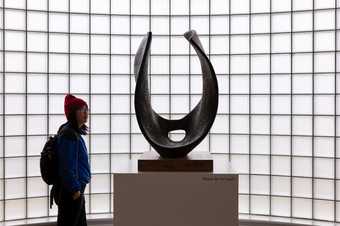See works from Tate's Collection in the rotunda
See Naum Gabo's Red Stone 1964–5 displayed alongside Barbara Hepworth's Curved Form (Trevalgan) 1956.
Gabo is probably best known for his geometrical constructions in plastics and metals. But his unusual sculpture Red Stone demonstrates his interest in more organic forms. It resembles a ridged shell, perhaps the curved spiral of an ammonite fossil. When Gabo lived in England from 1936–46, he spent much of his time with his friends, the artists Ben Nicholson and Barbara Hepworth, at St Ives on the Cornish coast. He became a keen collector of stones and pebbles found during walks along the beach.
Hepworth settled in St Ives during the Second World War. Inspired by the local landscape, she began to sculpt her responses to the natural forms around her. Trevalgan is the name of a hill near her home. There, she wrote, ‘the cliffs divide as they touch the sea-facing west. At this point, facing the setting sun across the Atlantic, where sky and sea blend with hills and rocks, the forms seem to enfold the watcher and lift him towards the sky.’ The sculpture is not a literal representation of the divided cliffs, but a personal expression of Hepworth’s physical and spiritual encounter with nature.
Tate St Ives
Entry to both the display and the gallery is free for Tate Members, Locals' Pass holders and under 18s.

